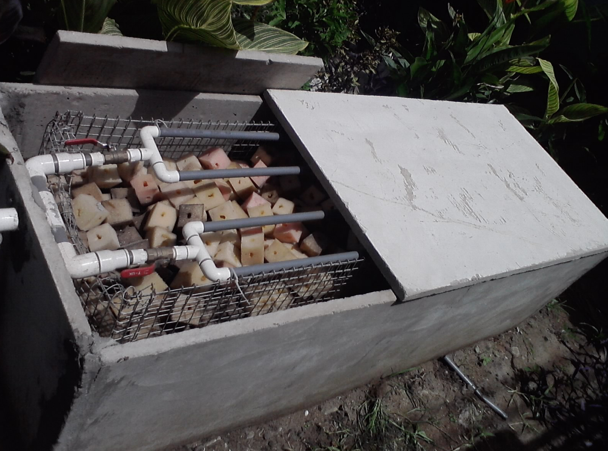OUR PRODUCTS
BIOFIL STANDALONE

The BiofilTM Standalone is an all-in-one unit that offers an onsite water closet and digester. With the option of a micro flush seat, the user simply presses a foot peddle to release the waste into a digester housed directly beneath the seat. The unit utilizes the water from each handwashing (as little as 500mL) to flush the toilet for the next user. This unit is ideal for areas with no access to water, this includes construction sites, resettlement communities and low income communities with no access to water.
The BiofilTM Standalone consists of a super- structure, a microflush seat, a handwash basin and digester.
BIOFIL TOILET DIGESTER

The toilet facility that makes good sanitation sense. The Biofil Digester is a simple compact on-site organic waste treatment system that uniquely combines the benefits of the flush toilet system and those of the composting toilets and eliminates the disadvantages and drawbacks of both systems. The Biofil Digester technology mimics the decomposition found under forests’ floors and other natural environments. Living organisms (both microorganisms and macro-organisms such as earthworms)in an enclosed environment treats all organic degradable matter through the natural process of aerobic decomposition. Wastewater and fecal matter enter at the top of the Biofil Digester where rapid separation of solids and liquid contents of the waste occurs.
The digester is essentially a biological filter consisting of a medium of soil and pervious concrete. Bacteria, other organisms degrade solid fecal matter. All liquids are organically filtered out of the bottom of the digester and drained into the soil where further and final decomposition occurs. Other solids (toilet paper & all degradable anal cleaning material) are decomposed and converted into rich & safe soil. When the Biofil Digester is used in the flush toilet situation, high nutrient biologically treated water is made available for effective landscaping and beautification of the environment.
BIOFIL RAINFOREST TREATMENT
The Biofil TM Rain Forest Treatment System is a centralized wastewater management solution at the core of which is the Biofil TM Digester. This solution is proposed for very dense areas. A cluster of households and/or houses are provided with Biofil TM Digesters and their effluent is treated collectively. With a small treatment step to remove solids, grey water can also be incorporated in this system for total household wastewater treatment. It will be ensured that final effluent from this system will meet all relevant local discharge guidelines or reuse application.
Rain Forest Treatment Systems or RFTS represents a technical approach rather than merely a product. Its applications are designed to be low-maintenance: most important parts of the system work without high energy inputs. RFTS are readily applicable and affordable because all of the materials used for construction are locally available.
1. RFTS provides treatment for organic wastewater at both domestic and industrial sources.
2. Systems can be designed to handle organic wastewater flows from recreational places, hospitality centres, offices, parks, apartment buildings etc.
3. RFTS can be used to replace failed septic tanks.
The system may comprise of one of the following components:
1. Vertical gardens
2. Sand filters
3. Reed/planted beds
4. Gabions
Advantages of RFTS technology:
1. Low initial investment costs as no imported materials or components are needed
2. Efficient treatment for discharge
3. Low maintenance costs
4. High potential for reclamation and reuse of treated wastewater
5. High nutrient recovery for crops/plants
6. Efficient system for cleaning of fish ponds
7. Good treatment for algal water
BIOFIL TRICKLING FILTER
Trickling filters (TFs) are used to remove organic matter from wastewater. The TF is an aerobic treatment system that utilizes microorganisms attached to a medium to remove organic matter from wastewater. These systems are known as attached-growth processes. It enable organic material in the wastewater to be absorbed by a population of microorganisms (aerobic, anaerobic, and facultative bacteria; fungi; algae; and protozoa) attached to the medium as a biological film or slime layer (approximately 0.1 to 0.2 mm thick). As the wastewater flows over the medium, microorganisms already in the water gradually attach themselves to the rock, slag, or plastic surface and form a film. The organic material is then degraded by the aerobic microorganisms in the outer part of the slime layer.
The trickling filter consists of a holding receptacle, filters, drainfield and pumping system.
The ON and OFF of the pump is controlled by the actions of both the float valve and the timer.